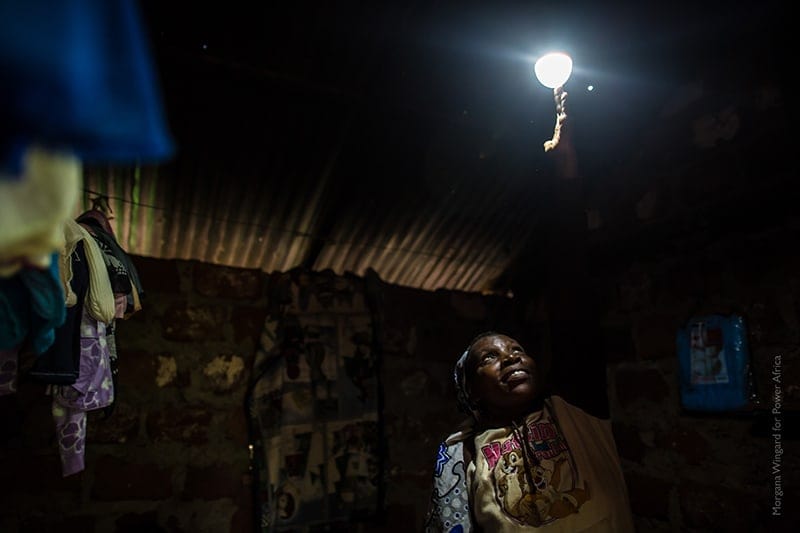A Cleaner Path: Solar Energy’s Impact on Health
- Blog
- Renewable energy

Imagine for a moment that the light used in your home was a poison. One that could damage your lungs, irritate your eyes, even impact the health of your unborn child. You’d think twice about flicking on that switch. Kerosene lamps—used by an estimated 290 million people across Africa—contribute to household air pollution. Such pollution is responsible for more deaths a year than tuberculosis, malaria and HIV combined.
Fortunately there is a solution that promises to make a big impact on improving household air quality. Solar products such as lanterns and rooftop systems offer a pollution-free, cost-effective alternative for lighting homes through the night. They can replace dimmer, older, dirtier forms of lighting, such as kerosene, which expose users to potentially severe health risks from smoke and soot. Solar is becoming increasingly popular in developing countries, led by the success of Acumen investees such as d.light, SolarNow and Devergy amongst others.
Despite decades of kerosene fuel usage, it is only relatively recently that there has been a recognition that smoke from kerosene lamps and cookstoves might present a serious health risk. Studies have associated kerosene use in homes with tuberculosis, and poor neonatal and maternal health. As a result the fuel is strongly discouraged by the World Health Organization (WHO) for household use.
While we know solar holds incredible potential for the poor, there is little research on how switching from kerosene to solar impacts a family’s health. In partnership with SolarAid and researchers from the University of California, Berkeley, and with funding from Google, we set about addressing this gap in knowledge. Our study in Busia County, Kenya, was focused on quantifying changes in exposure to fine particulate matter (PM), a common air pollutant, and carbon monoxide (CO) following a switch from kerosene to solar.
The study used a range of methods to measure exposure. These included traditional survey-based data collection but also a range of sensors that gathered precise information on pollution levels. Devices were fitted to kerosene and solar lamps to monitor duration of usage. Temperature changes were used to record the use of kerosene lamps. Solar lamp use was tracked by a sensor connected to the on/off switch. Instruments were fitted across the house to measure household concentrations of both PM and CO. And to measure personal exposure to PM and CO, two participants—typically the mother and a school pupil—wore vests containing light-weight monitors for 48 hours.
Here’s what we learned:
Kerosene users believe the fuel affects their health. More than nine out of ten of all household members said that kerosene lamps affected their breathing. A quarter of adults reported wheezing and three fifths of the children reported waking up at night to cough. Every child we spoke to complained that smoke in their eyes made it harder for them to read.
People prefer solar to kerosene. Our study gave three solar lamps to kerosene-using households. One month later, sensor-based measurements indicated that all houses had reduced their use of kerosene lamp by at least 90 percent, indicating a clear preference for solar above kerosene. Measurements also showed that this transition was rapid, occurring within days of receiving the solar lamps.
Solar users experienced a meaningful reduction in exposure to household air pollution. Prior to the introduction of solar lanterns, kerosene use was associated with substantial exposure to PM in both adults and schoolchildren. Reduction in exposure following the distribution of solar lamps averaged 73 percent among schoolchildren and 50 percent among adults. This finding is encouraging. This was a relatively short study, but if solar lamps continue to be used in place of kerosene lamps, it is likely that there would be health benefits as a consequence of the reduction in air pollution.
Achieving a “safe” level of exposure to pollution would require reducing use of other dangerous fuels. Unfortunately, kerosene is not the only potentially dangerous fuel the poor use on a daily basis. Our study found that, according to WHO standards, adults who made the switch to solar were still exposed to an unsafe level of pollution in their homes. This was in large part due to the use of “traditional” cooking stoves—open fires, typically burning wood or charcoal—which are also a major contributor to household air pollution. Therefore to achieve acceptably low levels of exposure for everyone in the family, it will be necessary to reduce other sources of pollution alongside kerosene.

To our knowledge, this is the first study of its kind to look specifically at the dangers of kerosene. By comparison, the negative impact of cooking indoors with firewood and charcoal has been studied extensively. This research is an important first step towards understanding how kerosene affects the health of low-income families. We believe that these lessons are vital for governments, businesses, and members of households responsible for making decisions that will impact the health and well-being of their families. If we want to reduce the scourge of household air pollution, it is essential to eradicate the use of kerosene. To that end, solar energy is our best bet.
If you would like to learn more about our research, you can find a summary report here, and the full academic paper here.
This is the second installment of a series of lessons from a range of new research into the social impact of off-grid energy in emerging markets. The research is complemented by Acumen’s own customer-based data collection applying our Lean Data approach. This work was originally conceived by Kat Harrison, formerly head of research and impact at SolarAid and now Acumen’s Associate Director of Impact.
